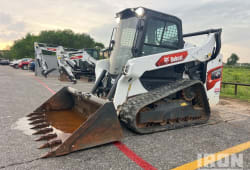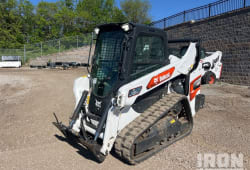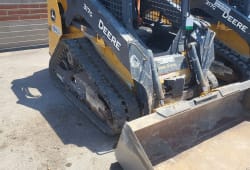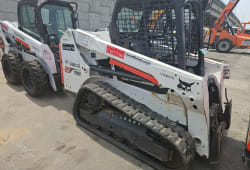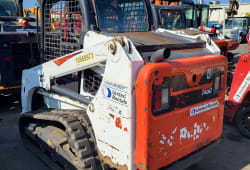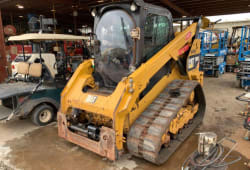Power and Versatility of the John Deere Compact Track Loader
9 Min read
)
December 21, 2023
The landscape of construction and agricultural machinery stands forever transformed by the advent of the John Deere Compact Track Loader. In this comprehensive exploration, we delve into the very essence of this groundbreaking equipment. From its inception to its technological prowess, versatility across industries, ergonomic design, and visionary sustainability, each facet reflects a testament to engineering marvel. As we embark on this journey, we unravel the intricate mechanisms, diverse applications, and the promising future innovations that signify the John Deere Compact Track Loader not just as a machinery but as a catalyst reshaping the norms of efficiency, performance, and sustainability in the industrial realm.
The Evolution: John Deere Compact Track Loader
The history and evolution of construction and agricultural machinery have been redefined by the advent of the John Deere Compact Track Loader. Its inception, technological advancements, and the impact it has made on various industries showcase its significance as a pioneer in modern equipment.
The Technology Behind John Deere Compact Track Loader
Delving into the intricate engineering aspects of the John Deere Compact Track Loader unveils a world of innovation. From the design principles to the integration of cutting-edge technology, every aspect contributes to its unmatched performance and reliability.
Exploring the Performance of John Deere Compact Track Loader
The John Deere Compact Track Loader stands tall as a game-changer in the construction and agricultural machinery landscape. Its robust build, coupled with cutting-edge technology, ensures unmatched performance across diverse terrains. Engineered to deliver exceptional power and precision, this loader redefines efficiency, making it a go-to choice for professionals seeking top-tier machinery.
Versatility Redefined: Applications of the John Deere Compact Track Loader
From heavy-duty lifting to precise maneuverability in confined spaces, the John Deere Compact Track Loader offers unparalleled versatility. Its adaptability in various tasks, such as landscaping, material handling, and site preparation, elevates productivity while maintaining optimal performance and control.
Features That Set the John Deere Compact Track Loader Apart
Equipped with advanced features like a powerful engine, spacious cab, and intuitive controls, the John Deere Compact Track Loader ensures operator comfort and enhanced functionality. Its innovative design minimizes downtime, maximizes efficiency, and guarantees a superior user experience.John Deere offers various models of compact track loaders, each designed with distinct specifications, benefits, and unique selling points (USPs) catering to different needs. Here are details about some of their top models:
John Deere 333G Compact Track Loader:
:format(webp)) Specifications: Equipped with a 3.8L diesel engine, rated at 100 hp. Offers a maximum operating capacity of around 3,700 lbs and a breakout force of 9,300 lbs.
Specifications: Equipped with a 3.8L diesel engine, rated at 100 hp. Offers a maximum operating capacity of around 3,700 lbs and a breakout force of 9,300 lbs.
Benefits: Superior stability, high lift heights, and increased hydraulic flow for attachments. Features enhanced cab comfort, intuitive controls, and advanced visibility.
USP: Best-in-class pushing power and a spacious, ergonomic cab for improved operator comfort and productivity.
John Deere 331G Compact Track Loader:
:format(webp)) Specifications: Powered by a 2.1L diesel engine with 331G providing around 90 hp. Offers a rated operating capacity of about 3,100 lbs and a breakout force of 8,500 lbs.
Specifications: Powered by a 2.1L diesel engine with 331G providing around 90 hp. Offers a rated operating capacity of about 3,100 lbs and a breakout force of 8,500 lbs.
Benefits: High lifting capabilities, versatile attachment options, and exceptional durability in challenging terrains.
USP: Incorporates John Deere's vertical lift design for improved stability and lift heights, ideal for heavy lifting and construction applications.
John Deere 317G Compact Track Loader:
:format(webp)) Specifications: Runs on a 2.4L diesel engine, delivering approximately 65 hp. Provides an operating capacity of about 1,700 lbs and a breakout force of 5,500 lbs.
Specifications: Runs on a 2.4L diesel engine, delivering approximately 65 hp. Provides an operating capacity of about 1,700 lbs and a breakout force of 5,500 lbs.
Benefits: Compact size for easy maneuverability, excellent traction, and versatility in various applications.
USP: Ideal for tight spaces and landscaping projects due to its smaller footprint and agility without compromising on power and performance.
John Deere 325G Compact Track Loader::format(webp)) Specifications: Fitted with a 2.4L diesel engine, producing around 74 hp. Offers an operating capacity of about 2,900 lbs and a breakout force of 8,600 lbs.
Specifications: Fitted with a 2.4L diesel engine, producing around 74 hp. Offers an operating capacity of about 2,900 lbs and a breakout force of 8,600 lbs.
Benefits: Smooth and precise control, optimized stability, and robust build for heavy-duty tasks.
USP: Balanced power-to-weight ratio, ensuring efficient performance in various working conditions.
Each of these models caters to different requirements based on power, lift capacity, size, and maneuverability. They excel in various industries, from construction and landscaping to agriculture, providing a blend of power, versatility, and operator comfort, making John Deere a sought-after choice in the compact track loader market.
Factors Influencing Cost
Several factors dictate the cost of John Deere compact track loaders. Model variations, with their unique specifications, determine pricing tiers, where advanced models command higher prices. Features like horsepower and lifting capacity significantly impact costs, alongside additional attachments that enhance versatility but add to expenses. Dealer pricing, influenced by location and demand, and the choice between new and used models also play pivotal roles in determining the final cost.
Model and Specifications: John Deere offers a diverse range of compact track loaders, each meticulously designed with its distinct features, capabilities, and specifications. The cost differentials emerge primarily due to the varying complexities and functionalities of these loaders. Higher-tier models, boasting advanced technological features or increased operational capacities, invariably command a premium price compared to their more basic counterparts.
Horsepower and Capacity: A loader's price is profoundly influenced by its horsepower and lifting capacity. Enhanced horsepower and greater lifting capabilities inherently inflate the loader's cost, as these attributes contribute to its performance and operational prowess. Loaders equipped with more substantial power and lifting capacities are priced higher due to their increased efficiency and utility in demanding tasks.
Attachments and Accessories: Additional attachments and accessories significantly impact the overall cost of a compact track loader. Items like buckets, forks, grapples, or specialized tools enhance the loader's versatility and operational scope but inevitably add to the expenses incurred by the purchaser. The costs rise in accordance with the number and complexity of these add-ons.
Dealer Pricing and Location: The pricing structures offered by different dealerships and their geographical locations play a pivotal role in determining the final cost of the compact track loaders. Variations in pricing, discounts, financing options, and even regional factors such as demand, taxes, or shipping expenses contribute to the fluctuation in the price range across various dealerships and locations.
New vs. Used: The contrast between new and used loaders significantly influences their respective costs. New loaders, characterized by warranties, updated technology, and pristine condition, command higher price tags. Conversely, pre-owned or used models tend to be more budget-friendly, although they may lack some of the latest features and technological advancements found in newer counterparts. The cost discrepancy between new and used loaders is often substantial, making this choice a critical consideration for prospective buyers.
Average Cost Range
Model Variations: The spectrum of cost within John Deere's compact track loader lineup is broad. Entry-level models like the John Deere 333G typically start in the range of $40,000 to $50,000, whereas the more advanced iterations, such as the John Deere 333G with heightened features and greater lifting capacities, can exceed $80,000, reflecting the diverse pricing based on specifications.
Horsepower and Capacity: Loaders equipped with elevated horsepower and lifting capacities, such as the John Deere 333G or the 333G Forestry models, tend to fall within the higher price range due to their augmented capabilities. These loaders, designed for more demanding tasks, come at a premium cost commensurate with their increased performance metrics.
Attachments and Accessories: The incorporation of additional attachments and specialized tools contributes significantly to the loader's overall cost, potentially increasing it by several thousand dollars. The specific requirements and complexities of these accessories account for the variance in the final cost of the loader.
Dealer Pricing and Location: The final cost of compact track loaders can vary significantly based on dealership-specific pricing policies, regional demand dynamics, and operational expenses. Dealer discounts, promotional offers, and variations in pricing structures can influence the overall cost experienced by buyers in different regions.
New vs. Used: Used compact track loaders, typically available at lower price points compared to their new counterparts, range in cost from $25,000 to $70,000 based on factors like age, condition, and specifications. This considerable price gap underscores the cost-effectiveness of opting for used models despite potential trade-offs in terms of the latest features and technological advancements.
The Future of Efficiency: John Deere Compact Track Loader
As industries evolve, the demand for agile and powerful machinery grows. The John Deere Compact Track Loader stands as a beacon of innovation, promising a future where efficiency and performance converge seamlessly to meet the evolving needs of various sectors.
Final Words
The John Deere Compact Track Loader epitomizes a transformative force in construction and agriculture machinery. Its inception, technological advancements, and versatile applications underscore a paradigm shift. This engineering marvel, boasting sustainability, ergonomic design, and visionary capabilities, doesn't merely represent machinery but serves as an avant-garde catalyst reshaping efficiency, performance, and sustainability in industries. As we unravel its mechanisms and innovations, it's evident: the John Deere Compact Track Loader is more than equipment; it's a progressive force redefining industrial norms.



